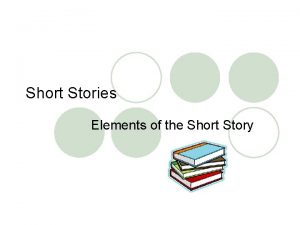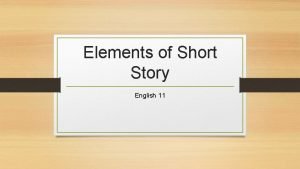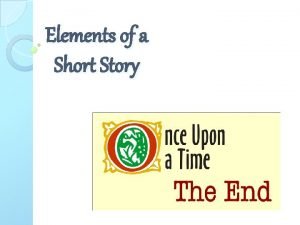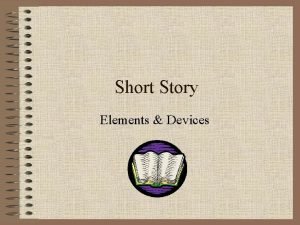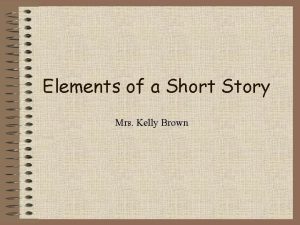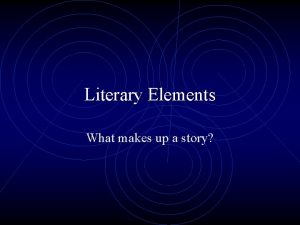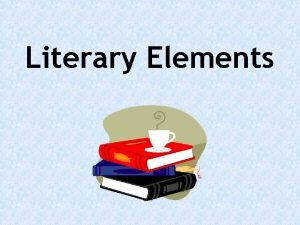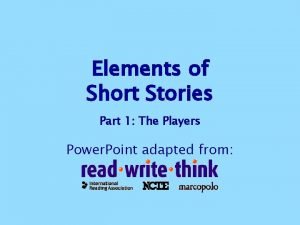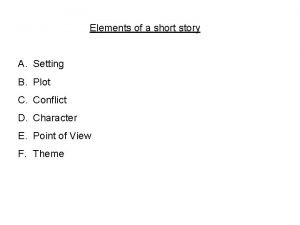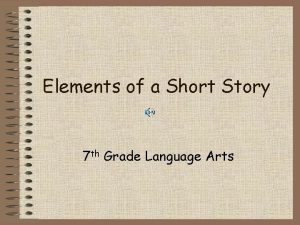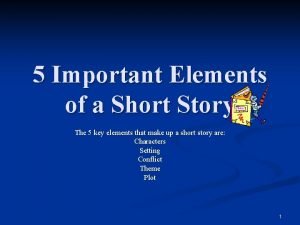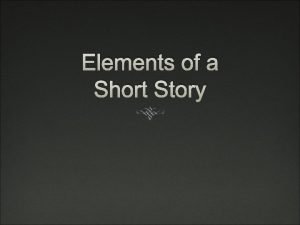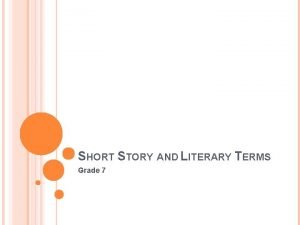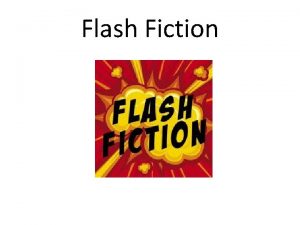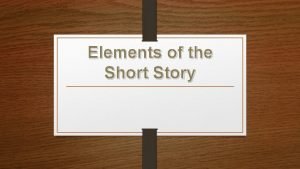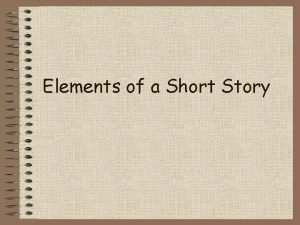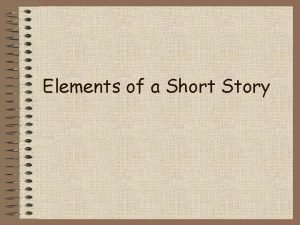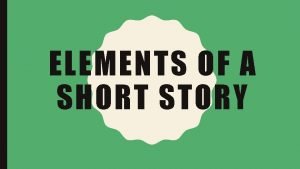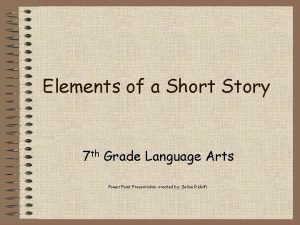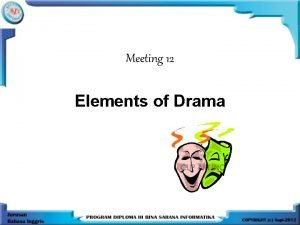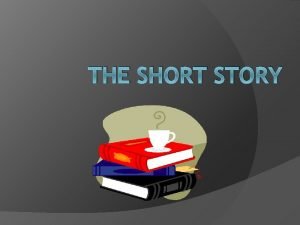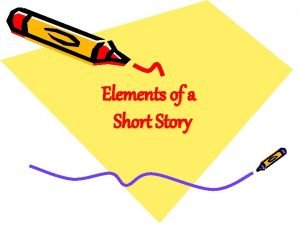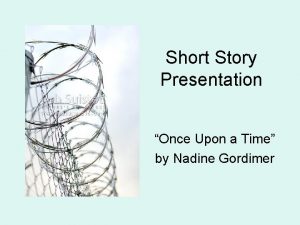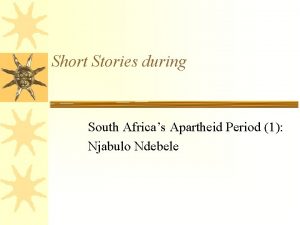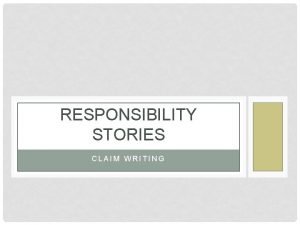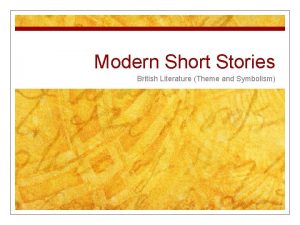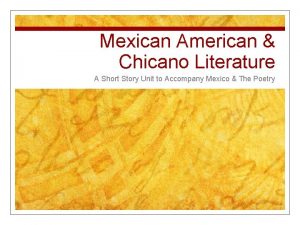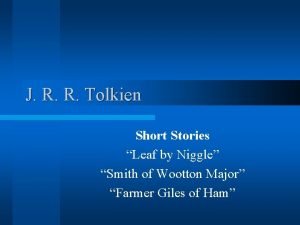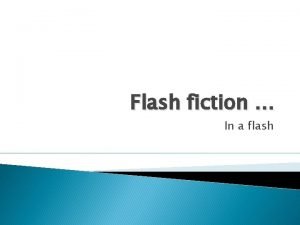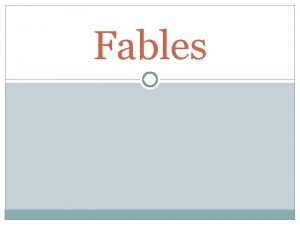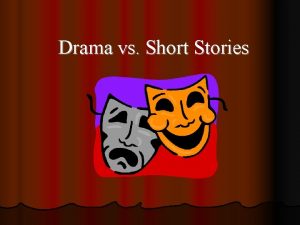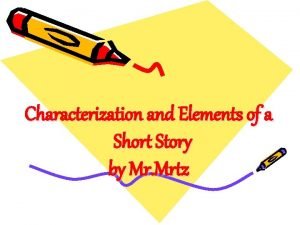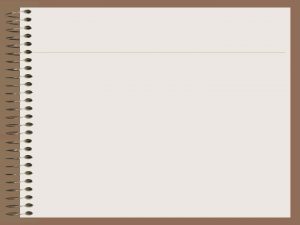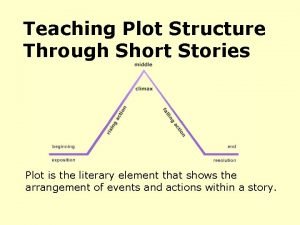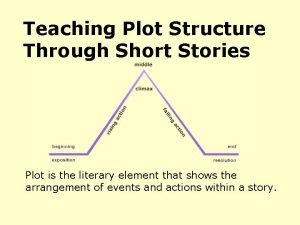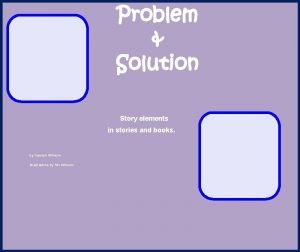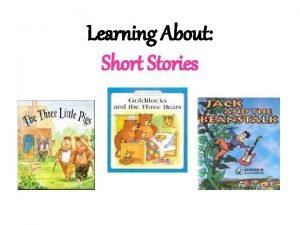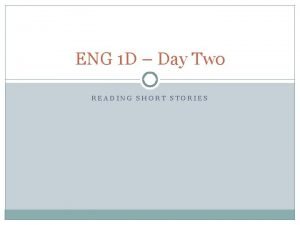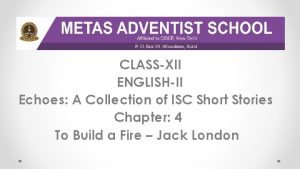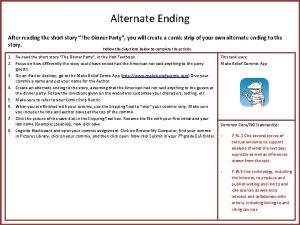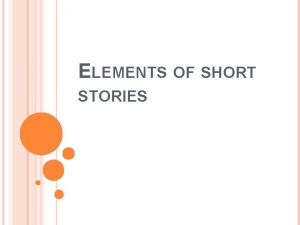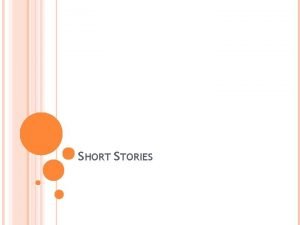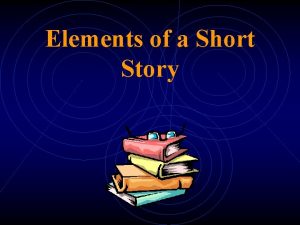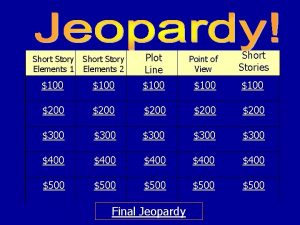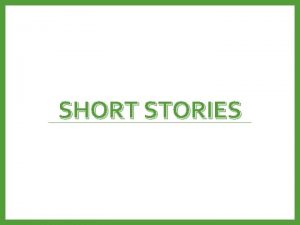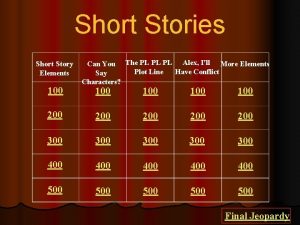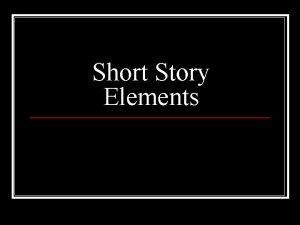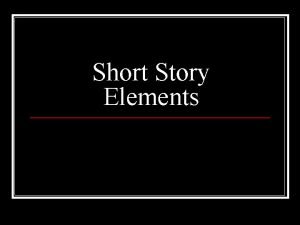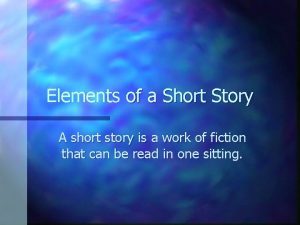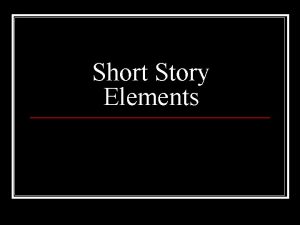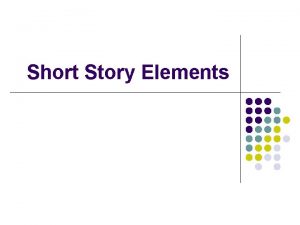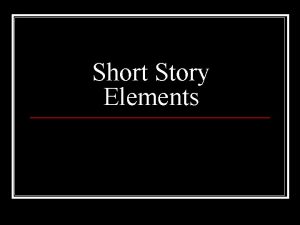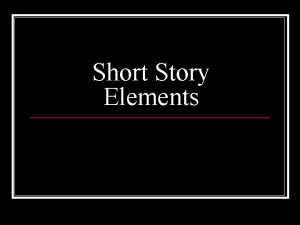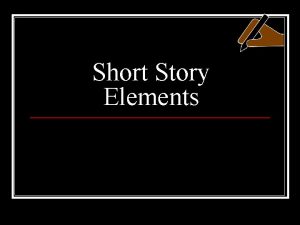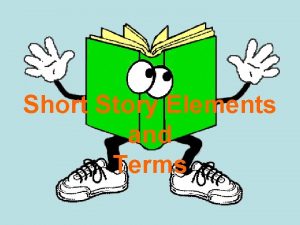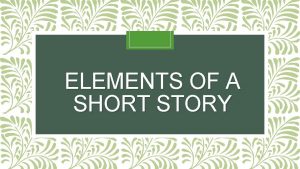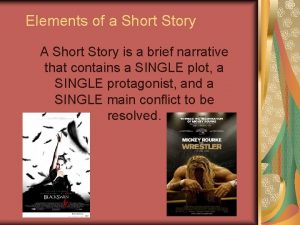Short Stories Elements of a Short Story What















































- Slides: 47

Short Stories Elements of a Short Story

What is a Short Story? • A brief, fictional (not true), narrative type of prose that involves conflict, characters, a situation, and a setting that describes the action in the form of a plot. • It can usually be read in one sitting. • A short story has few characters (usually one or two main characters)

Setting • The setting of a story is the time and place the story took place. The setting helps develop the plot. • A scene is a specific setting for a given event in a story.

PLOT • A plot is the sequence of events or what happens in the story. The plot consists of five areas: 1. exposition 2. rising action 3. climax 4. falling action 5. resolution

Plot: Exposition • The exposition is the introduction of the short story. This is the part of the story that describes the background of the characters and the action so the reader can understand the situation.

Plot: Rising Action • After the exposition is the rising action, which is the part of the story where the tension between opposing characters begins to build and begins working toward the climax.

Plot: Climax • The climax is the turning point of the story. The climax is usually the point of greatest interest or intensity. The climax is where something happens that will affect the outcome.

Plot: Falling Action • The falling action is the series of events following the climax. This is where the plot begins to unravel and approaches the resolution.

Plot: Resolution • The resolution is the last part of the plot. The resolution is the outcome or solution of the story.


Conflict • The conflict of the story is the struggle between opposing forces. The conflict can be external or internal.

Internal Conflict • In an internal conflict, a character struggles against his or her own emotions, needs, or desires.

External Conflict • In an external conflict, a character struggles against an outside force, which may be another character, society, or something in nature.

Types of Conflict: #1 • Man vs. Man: Two people in conflict • Example: Jason vs. Freddy

Types of Conflict: #2 • Man vs. Himself: inner conflict • Example: Beautiful Mind, Fight Club

Types of Conflict #3 • Man vs. Nature: natural forces, storms, animals Example: The Day After Tomorrow

Types of Conflict: #4 • Man vs. Fate: Man has no control Example: Odyssey; Final Destination

Types of Conflict: #5 • Man vs. Society: Against the system or authority • Example: John Q

Types of Conflict: #6 • Man vs. Supernatural: Ghosts, extraterrestrials, etc. • Examples: The Ring, Signs, The Blair Witch Project

Irony • • Irony is the contrast between expectations and reality. There are three types of irony: 1. Verbal irony 2. Situational irony 3. Dramatic irony

Verbal Irony • Verbal Irony is when a speaker says one thing but means the opposite.

Situational Irony • Situational irony is when what actually happens is the opposite of what is expected or appropriate.

Dramatic Irony • Dramatic irony occurs when the reader or audience knows something important that a character does not know.

Characters • Each short story has characters. A character is a fictional personality created by the author. A character always has human traits, even if the character is an animal.

Protagonist • A protagonist is the character we focus our attention on, the person who sets the plot in motion. • The protagonist is the main character. • Most protagonists are rounded, dynamic characters who change in some way by the end of the story. The protagonist is often, but not always, the hero in the story.

Antagonist • An antagonist is the character or force that blocks the protagonist. • The antagonist is often, but not always, the villain in the story. • The antagonist is the person trying to prevent the protagonist from being successful.

Types of Characters • Characters can be described as one of the following types: 1. Static 2. Dynamic 3. Flat 4. Round

Static Character • A static character does not change much during the story. • Example: Smokey on “Friday”

Dynamic Character • A dynamic character changes in some important ways as a result of the story’s action. • Example: Marlin (dad) in Finding Nemo

Flat Character • A flat character has only one or two personality traits and can be summed up in a single phrase. • Examples: Will’s Aunt in the “Fresh Prince of Bel-Air” and Mr. Burns in “The Simpsons”

Round Character • A round character is complex and has many different traits. • Example: Will Smith on “The Fresh Prince of Bel-Air”

Direct Characterization • The first method (#1) is called direct characterization. The writer tells us directly what the character is like.

Indirect Characterization • The other 5 methods (#2 -6) are indirect characterization. The reader has to put clues together to figure out what a character is like, just as we do in real life when we are getting to know someone.

MODES OF INDIRECT CHARACTERIZATION 1. describing how the character looks or dresses. 2. letting us hear the character speak 3. letting us listen to the character’s inner thoughts and feelings 4. revealing what other people think or say about the character 5. showing the character’s action

Point of View • • The point of view is the vantage point from which the writer (narrator) tells the story; through whose eyes the story is told. The three types of point of view are: 1. Third person omniscient 2. third person limited (he, she, they) 3. first person (I)

Third Person Omniscient Point of View • The “all knowing. ” With this point of view, the narrator does not play a part in the story, but can tell the readers what all the characters are thinking, feeling, and what is happening in other areas.

Third Person Limited Point of View • Third person limited is when the story is seen through the eyes of only one character and this character is an outside narrator.

First Person Point of View • Is when the narrator, using the firstperson pronoun “I, ” is a character in the story. When we read in first person, we hear and see only what the narrator hears and sees.

Tone • As the details are woven together, the author’s word choice and details indicates the tone.

Tone • Authors have a wide selection of tone. For example, an author can be amused, disgusted, shocked, teasing, outraged, happy, etc. • One tone the author may choose to utilize is irony.

Theme • One of the chief aspects of any story is theme, or the main idea, which inspired the story. The theme of the story is often the message about life that the author is trying to convey. The theme is the moral of the story.

Theme • Two of the most important clues to consider when determining theme are the way the main character has changed and the way the conflict has been resolved.

Imagery • Imagery refers to the type of language used that appeals to the senses. Imagery will appeal to the sense of sight, smell, sound, touch, or taste. • For example, the language allows the reader to see what the character is seeing.

Symbol • A symbol is a person, place, thing, or event that represents an abstract idea. • For example, a heart symbolizes love and a flag symbolizes patriotism.

Foreshadowing • Foreshadowing is a suggestion, by the author, of events to come later on in the story.

Dialogue • Dialogue is a conversation between two or more characters.

Title • The title of the story should trigger some definite thoughts or pictures in your mind about what the story may be about. • Examples: “The Cop & The Bottle”: drunk driving • “The Stage & The Pole”: stripping, but really about the death of Lincoln.
 Short short short long long long short short short
Short short short long long long short short short Short story parts
Short story parts 5 elements of story
5 elements of story Objective in a story
Objective in a story Elements of the short story
Elements of the short story Five story elements
Five story elements Short stories
Short stories Story elements story
Story elements story Elements of a short story video
Elements of a short story video Elements of a short story
Elements of a short story Elements of a short story powerpoint
Elements of a short story powerpoint Setting in a short story
Setting in a short story Elements of a short story grade 7
Elements of a short story grade 7 5 element of a short story
5 element of a short story Identify the elements of short story. *
Identify the elements of short story. * Short story with characters, setting and plot
Short story with characters, setting and plot Flash fiction and short story elements
Flash fiction and short story elements Plot diagram explanation
Plot diagram explanation Resolution in a story
Resolution in a story Story elements definition
Story elements definition Story elements definitions
Story elements definitions Elements of story
Elements of story What are the features of drama in literature
What are the features of drama in literature Resolution of cinderella story
Resolution of cinderella story Elements of a good story
Elements of a good story Short story objectives
Short story objectives Short story presentation
Short story presentation Some stories
Some stories Short stories about apartheid
Short stories about apartheid Short stories on accountability
Short stories on accountability British literature short stories
British literature short stories Chicano literature short stories
Chicano literature short stories Short stories with main idea
Short stories with main idea Tolkien short stories
Tolkien short stories The sea devil plot diagram
The sea devil plot diagram Currents by hannah bottomy summary
Currents by hannah bottomy summary Short story fable
Short story fable Drama vs short story
Drama vs short story Short stories characterization
Short stories characterization What is mean by short story
What is mean by short story Shrek rising action
Shrek rising action Teaching plot
Teaching plot Problem and solution story
Problem and solution story Essential questions for short stories
Essential questions for short stories Short stories for grade 10
Short stories for grade 10 Eng1d short stories
Eng1d short stories Echoes a collection of isc short stories
Echoes a collection of isc short stories Alternate ending short story
Alternate ending short story

